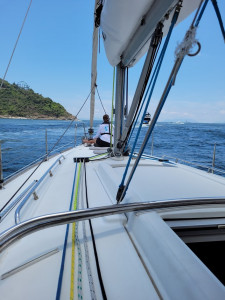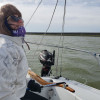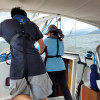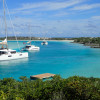Not sure what to expect when you are trying to get bareboat qualified?
ASA 101 was probably the most challenging but also the most rewarding. The classroom side of the course was the most intensive and entailed learning a significant amount of new vocabulary and concepts. It was, in the most traditional sense, a 101 “intro to” class where you learn all the basic parts, points, concepts and vocabulary. From the classroom we spent time learning how to rig up a keelboat (J24), and finally got to spend several hours on the water doing all the basic sailing tasks like tacking, jibing, adjusting sheets, halyards, and man overboard drills. This class was not difficult, but it was the most difficult of the three, just because of the sheer volume of new things that you must learn.
ASA103- I felt like 103 was 101 but in the “big leagues”. The classroom portion was much less intensive, and we spent much less time on the vocabulary and basics of sailing. More time was spent on slightly more advanced topics like weather, navigational chart reading, and more advanced rules or the road (water?). We spent more time on the water than in the classroom on a larger boat (34), and spent the bulk of the time doing drills on tacks, jibes, heaving to, and using the engines to pick up moorings and such. The required sailing skills were reasonable to accomplish, and the test wasn’t very difficult.
ASA 104- This one felt more like a charter! The classroom piece was a little bit more intensive than 103, introducing some more advanced topics like more advanced charts and navigation. We learned and had to show we knew how to live on the boat by provisioning, cooking, and doing everything you would normally do on a charter. We were on the boat for from Friday night to Sunday night, and had two all day sails covering 25 and 35 miles. Less time was spent on tacking and jibing drills (we tacked when we actually needed to), and the general feel of the sailing was similar to what you would experience on a charter. The test had a few sections that were more difficult than the other tests, just due to some fuel consumption/ETA and other navigation-based math.
Tips- Get the books! Our 101 recommended them and taught from them, but our 103 and 104 did not. Personally, I was very happy to have read the books and have done all of the practice quizzes before we got to class. They made the material, and the testing quite simple. If you can’t commit to all 3 classes, take 101. Even if you are just going to be crew on a charter, many of the things you learn in 101 will be extremely helpful. Also, while I learned a lot from the classes, I would not recommend going right from these 3 classes, and onto a charter alone unless you had prior charters as crew, or a co-captain with more experience to back you up.














